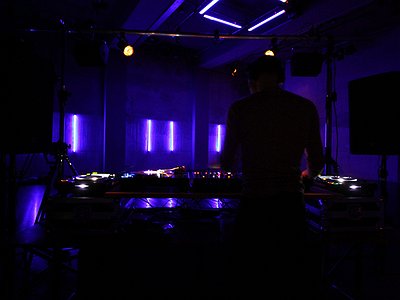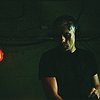Part 2
Could you take us through a day in your life, from a possible morning routine through to your work? Do you have a fixed schedule? How do life and creativity feed back into each other? Do you separate them or instead try to make them blend seamlessly?
Not one day in my life is like the other. It's impossible to lay out a certain schedule. My everyday life consists of many different pieces, due to many very different projects and duties. It also includes lots of traveling and commuting. The work I do makes out a big part of my life, so everything is kind of interwoven. In my experience, you can only be creative, when you are in a relaxed mood and you're able to let your imagination flow. Hence, my overall goal is to find a suitable balance between work and recreation.
Let's say you have a gig coming up tonight. What does your approach look like – from selecting the material and preparing for, opening and then building a set?
If I decided to play a vinyl set I already started days before to formulate an idea, because I will be limited in how many records I can carry. It would be almost the same if I would play digital. Most likely, I will have listened to some folders containing tracks that I wanted to play for that occasion. The goal is to get the respective tracks that make out my idea into my RAM. For this purpose I try to imagine what the venue might feel like and also the crowd and bring some of my actual moods into it. Before a show I make sure that I check out the dancefloor. I'll check the sound and the audience and try to combine my impressions with the ideas from home. In that moment I also choose how to start my set and how to take over from the DJ before me. The rest happens during the set.
Can you describe your state of mind during a DJ set? What supports this ideal state of mind and what are distractions? Are there strategies to enter into this state more easily?
During a set I bring myself into kind of a meditation. I dive deep into myself and into the music and try to connect with the crowd. I easily get into this state of mind when nothing distracts me and the DJ booth offers a good sound. It helps a lot when I have the feeling to stand directly in the music and that I can judge everything I do from my position.
What distracts me? Technical issues do. If the sound is bad or the decks aren't working properly, that uses up a lot of energy which I could spend otherwise for creating a flow. Sometimes people distract me; some want to talk and don't seem to recognise that I am focused on my work here, others bump into the DJ table (some others clap their hands in the wrong rhythm). It is also very annoying when I can't find a track or record I am looking for.
What are some of the considerations that go into deciding which track to play next? What makes two tracks a good fit? How far do you tend to plan ahead during a set?
I can't give any prescription for that. I'd like to decide track by track if the vibe needs to be continued or changed with the next one. With 4 CDJs for instance, I can plan ahead some steps and avoid bothersome scrolling for the next track. This leads to faster mixing operations and helps to maintain my meditation state of mind.
Would you say you see DJing as improvisation? As composition in the moment? Or as something entirely different from these terms?
Most of my sets are completely improvised. I draw conclusions of the mood on the floor and add the vibes of the music to it. So it is indeed a composition in this very moment in the club. While playing, I make use of the tools I put together before the gig. I usually prepare my vinyl sets loosely because of limited bag capacity. Only a few vinyl sets are prepared completely. For those limited occasions I develop an idea at home and like to present it during a show. But I always leave room for a short cut or a detour in case it doesn't work out.
For a closing set at Berghain the only good strategy is to take a deep breath, calm down and cope with the situation you are going find in front of you. There is no way of planning 8 to 12 hours ahead, which means you will want to improvise anyway.
How do playing music at home and presenting it in the club compare and relate? What can be achieved through them, respectively, and what do you personally draw from both?
You can develop ideas at home. I do that quite a lot. But you need to have a good ability to envision your idea in the club. The differences are in the amplification of the music, the presence of a crowd, the accompanying lights, the DJ before you and the overall mood in the venue. I always compare idea and realization and try to learn from it.
How would you describe the relationship between your choices and goals as a DJ and the expectations, desires and feedback of the audience? How does this relationship manifest itself during a performance and how do you concretely tap into it?
I clearly manipulate the audience with the tools I know that work out to reach my goals. I like to take the audience on a guided journey to explore my musical world. But I always check what the crowd has to offer. If there is no reaction at all, I will continue my tour and they are just inactive passengers. When I manage to communicate with them, we both profit from it. If they show interest and start expressing a demand, they can make me dive deeper into a certain topic or search for other directions, which is very fulfilling as a music lover.
Especially thanks to the storage facilities of digital media, DJ sets could potentially go on forever. Other than closing time, what marks the end of a DJ performance for you? What are the most satisfying conclusions to a set?
In my experience, the set length is not a question of digital storage devices. It is rather a question whether you are willing to make a choice. You have to know your stuff inside out, and you have to have the calmness to improvise when necessary, for it is helpful to know some B-side tracks. And you need to know, how many records you are willing to carry. When doing all night long sets back in the 1990s, I took 2 crates of records with me. Sven Väth, Freddy K, Theo Parrish, they still carry tons of records and play extended vinyl sets. I use to play a lot of records for a closing set at Berghain, because it is less tiring due to the physical interaction.
I rather see a DJ set in the context of the whole night. It can connect with other sets before and after or it can stand alone as a vibe changer, all depending on the vibe of the night. The end of a set is reached when you bring the audience to a state where it can be picked up by the next DJ, either totally destroyed and ready for a re-start or hungry for more. At closings, I try to bring them down from their long trip. I twist them around a bit and make them shake off the straight beats. I decelerate them and then touch down safely on the grounds of reality.
Art can be a purpose in its own right, but it can also directly feed back into everyday life, take on a social and political role and lead to more engagement. Can you describe your approach to art and being an artist?
Every form of art is a way of expressing certain messages. It can show something that was unseen before, it can be controversal and provoke questions, it can be obnoxious, but everything with the purpose of moving something in the recipient, leading to a reaction or a change of mind. The way of expressing doesn't necessarily have to include words. I don't see it as a must, because we speak way to often about a topic and then we don't apply action as a consequence of that. Music and the feelings connected to it are hard to describe with words anyway. I see my music as a way of showing the audience my very own perception of life. This includes experiencing a certain freedom: breaking the rules, taking risks, making changes, and, showing some personal moods.
This approach works quite well with the dance projects I participate in. The French choreographer Frederic Gies combines classical and contemporary dance moves with the energy he experiences in the club culture. I provided the music for some of his works over the past 6 years. The key to our understanding is the openness towards each other. We manage to connect without explaining a lot through words, just exchanging non-verbal ideas with him showing me the moves he wants to integrate and me presenting him the music I think that would fit. The professional dancers involved and a non-techno audience were able to follow as well.
The experience of opening their minds for something unknown is sometimes new for the audience. They carry this feeling home and might say: „Yeah, I heard something tonight that wasn't techno, but I enjoyed to dance to it.“ or „I am not an outspoken techno fan, but I liked the energy that this music created during the performance.“ It touches people more on a human level than on an intellectual one and contributes to create interest, understanding and respect towards the new or unknown.
This experience is a steady companion through all those years I am involved in the scene as a raver and as an artist. Music is a universal language to express a message without using words. You will find likeminded people all over the world who then share or pass on the message.






